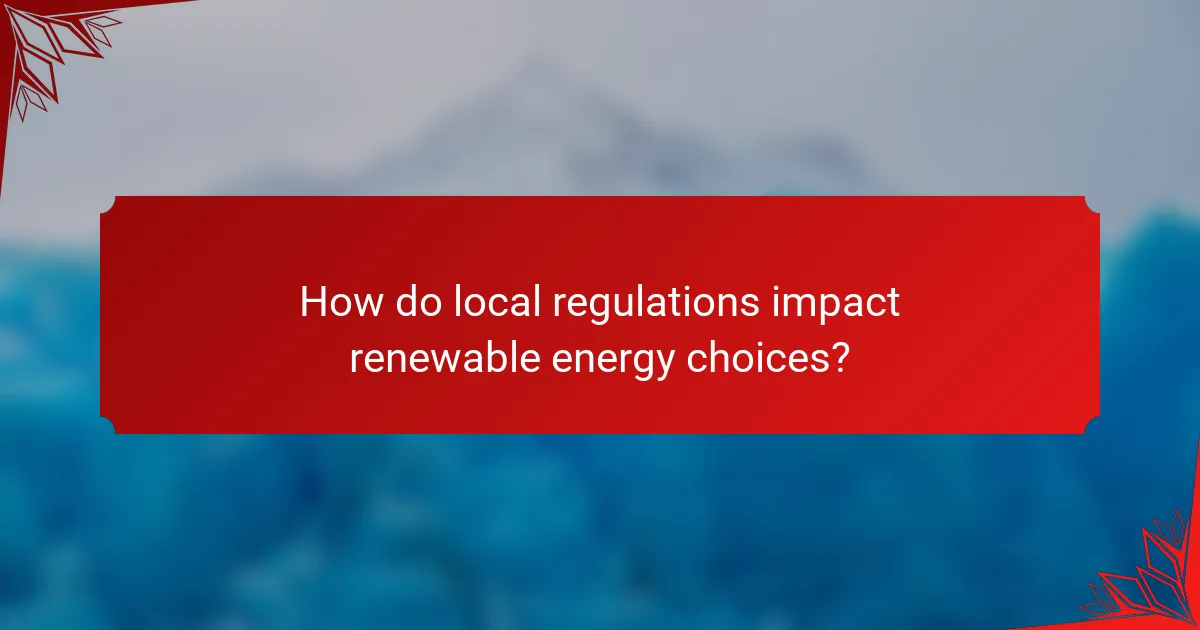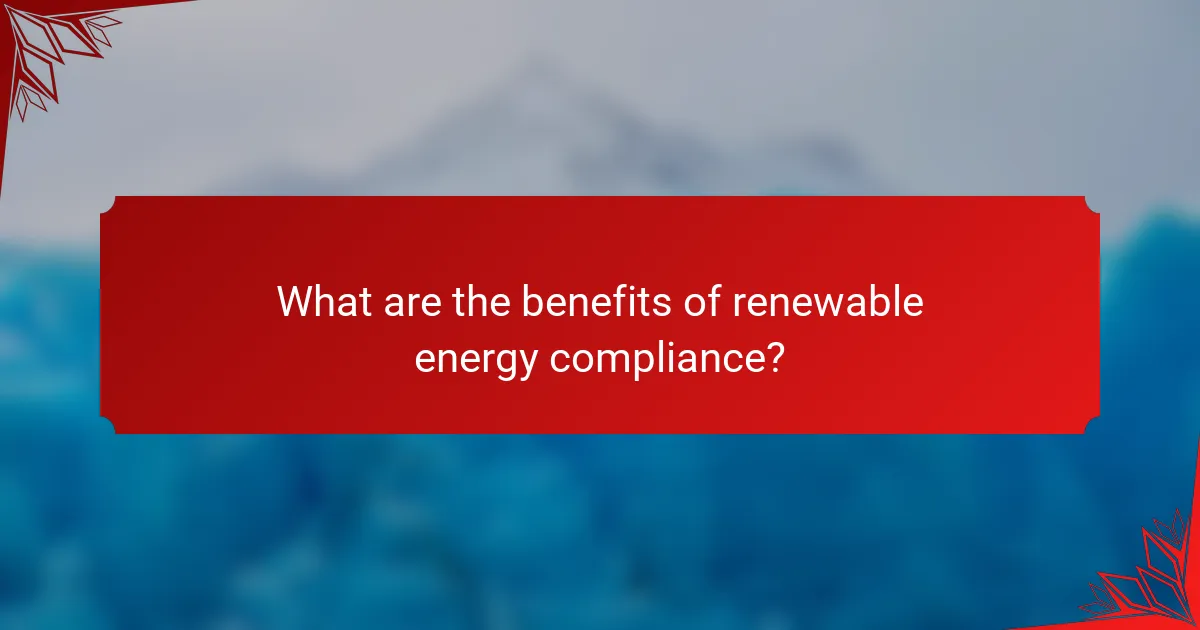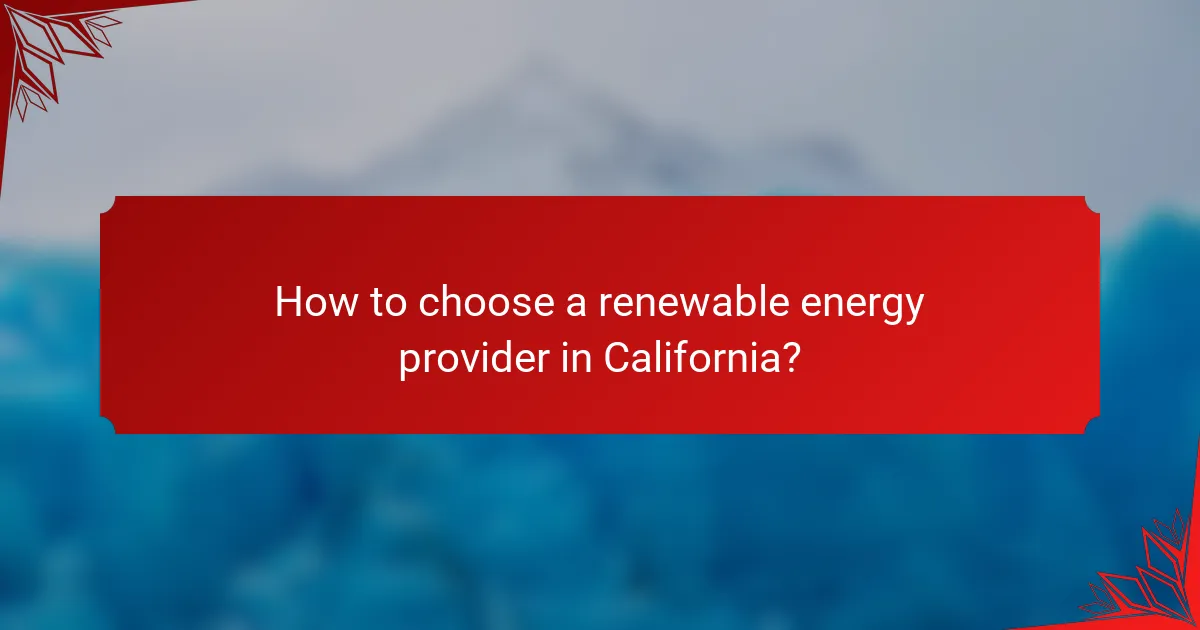In California, residents and businesses have access to a variety of renewable energy options such as solar, wind, and geothermal. Local regulations play a critical role in shaping these choices by outlining permissible technologies, installation requirements, and available financial incentives. Understanding these regulations is essential for making informed decisions that not only comply with the law but also promote sustainability and energy independence.

What renewable energy options are available in California?
California offers a diverse range of renewable energy options, including solar, wind, geothermal, biomass, and hydropower. Each option has unique characteristics, benefits, and considerations for implementation, making it essential for residents and businesses to evaluate their specific needs and local regulations.
Solar energy
Solar energy is one of the most popular renewable options in California, thanks to abundant sunshine. Homeowners can install photovoltaic (PV) panels to convert sunlight into electricity, often benefiting from state incentives and rebates.
When considering solar energy, evaluate your roof’s orientation and shading, as these factors significantly affect efficiency. Many residents find that solar installations can reduce electricity bills by a substantial percentage, often recouping initial costs within a few years.
Wind energy
Wind energy harnesses the power of wind through turbines to generate electricity. California has several wind farms, particularly in areas with consistent wind patterns, such as the Tehachapi and Altamont Pass regions.
For individual use, small wind turbines can be installed, but they require sufficient wind speeds and space. It’s crucial to check local zoning laws and regulations before installation, as they can vary significantly by area.
Geothermal energy
Geothermal energy utilizes heat from the Earth’s core to generate electricity or provide direct heating. California has significant geothermal resources, particularly in the Geysers region, which is one of the largest geothermal power plants in the world.
For residential use, geothermal heat pumps can be an efficient way to heat and cool homes. However, installation can be costly, and it’s essential to assess the suitability of your property for such systems.
Biomass energy
Biomass energy is produced from organic materials, such as wood, agricultural residues, and waste. California promotes biomass as a renewable resource to reduce landfill waste and generate energy.
When considering biomass, it’s important to ensure a sustainable supply of materials. Local regulations may govern the types of biomass that can be used, so checking with local authorities is advisable.
Hydropower
Hydropower generates electricity by using flowing water to turn turbines. California has numerous hydroelectric facilities, primarily in mountainous regions, contributing significantly to the state’s renewable energy portfolio.
For small-scale applications, homeowners can consider micro-hydropower systems if they have access to a suitable water source. However, environmental regulations regarding water use and ecosystem impact must be carefully reviewed before proceeding with installation.

How do local regulations impact renewable energy choices?
Local regulations significantly influence renewable energy choices by dictating what technologies can be used, how they must be installed, and what financial incentives are available. Understanding these regulations is crucial for making informed decisions about renewable energy investments.
Permitting requirements
Permitting requirements vary widely by location and can affect the installation of renewable energy systems like solar panels or wind turbines. Typically, homeowners or businesses must submit applications to local authorities, which may include site plans, engineering drawings, and environmental assessments.
In some regions, the permitting process can take weeks to months, so it’s essential to check local guidelines early in your planning. Be aware that certain areas may have stricter regulations, particularly in historic districts or environmentally sensitive zones.
Incentives and rebates
Many local governments offer incentives and rebates to encourage the adoption of renewable energy technologies. These can include tax credits, cash rebates, or grants that significantly reduce the upfront costs of installation.
For example, some states in the U.S. provide rebates that cover a portion of solar panel costs, while others may offer property tax exemptions for renewable energy systems. Researching local programs can help you maximize financial benefits.
Compliance standards
Compliance standards ensure that renewable energy systems meet safety and performance criteria. These standards can include building codes, electrical codes, and specific regulations for renewable technologies.
Failure to comply with these standards can result in fines or the need to remove or modify installations. It’s advisable to consult with local authorities or professionals familiar with compliance requirements to avoid potential pitfalls.

What are the benefits of renewable energy compliance?
Renewable energy compliance offers numerous advantages, including cost savings, reduced environmental impact, and enhanced energy independence. By adhering to regulations and standards, individuals and businesses can optimize their energy use and contribute to a sustainable future.
Cost savings
Complying with renewable energy regulations can lead to significant cost savings over time. By investing in solar panels or wind turbines, homeowners and businesses can reduce their reliance on traditional energy sources, which often come with fluctuating prices. Additionally, many regions offer tax incentives or rebates for renewable energy installations, further lowering upfront costs.
It’s important to evaluate the long-term financial benefits against initial investments. For example, while solar panel installation may require a substantial upfront cost, the return on investment can be realized within a few years through lower energy bills and available incentives.
Environmental impact
Renewable energy compliance plays a crucial role in minimizing environmental harm. By utilizing clean energy sources, such as solar, wind, and hydroelectric power, individuals and businesses can significantly reduce greenhouse gas emissions and air pollutants. This shift not only helps combat climate change but also promotes healthier communities.
Moreover, adhering to renewable energy standards often involves using sustainable practices in energy production and consumption. This can include reducing waste, conserving water, and protecting local ecosystems, which further enhances the positive environmental impact.
Energy independence
Renewable energy compliance fosters energy independence by reducing reliance on imported fossil fuels. By generating energy locally through renewable sources, communities can enhance their resilience against global energy market fluctuations and geopolitical tensions. This independence can lead to greater energy security and stability.
Investing in renewable energy technologies, such as solar or wind, empowers individuals and businesses to take control of their energy production. This not only supports local economies but also encourages innovation and job creation in the renewable energy sector.

What are the penalties for non-compliance?
Penalties for non-compliance with renewable energy regulations can include financial fines, legal actions, and other consequences depending on the severity of the violation. Understanding these penalties is crucial for businesses and individuals involved in renewable energy projects to avoid costly repercussions.
Fines and fees
Fines for non-compliance can vary widely based on the specific regulations violated and the jurisdiction. In many cases, fines can range from a few hundred to several thousand dollars, depending on the nature of the infraction. For example, failing to meet renewable energy production targets may incur fees that escalate with repeated violations.
Additionally, some jurisdictions may impose administrative fees for late submissions of required documentation or permits. It’s essential to stay informed about local regulations to avoid unexpected costs.
Legal repercussions
Legal repercussions for non-compliance can include lawsuits, injunctions, or even criminal charges in severe cases. Regulatory bodies may initiate legal action against entities that consistently fail to adhere to renewable energy standards, which can lead to costly litigation and damage to reputation.
In some regions, repeat offenders may face stricter penalties, including the suspension of operational licenses or permits. Engaging legal counsel familiar with renewable energy laws can help navigate these risks effectively.

How to choose a renewable energy provider in California?
Choosing a renewable energy provider in California involves evaluating their reputation, service offerings, and pricing structures. It’s essential to assess these factors to ensure you select a provider that aligns with your energy needs and sustainability goals.
Provider reputation
Start by researching the reputation of potential renewable energy providers. Look for customer reviews, ratings, and any awards or certifications they may have received. Reliable providers often have a strong track record of customer satisfaction and transparency.
Consider checking resources like the California Public Utilities Commission (CPUC) for information on provider performance and compliance with state regulations. Engaging with local community forums can also provide insights into the experiences of other customers.
Service offerings
Evaluate the range of services offered by each renewable energy provider. Some may focus solely on solar energy, while others might offer a mix of solar, wind, and other renewable sources. Understanding the types of energy solutions available can help you choose a provider that meets your specific needs.
Additionally, consider whether the provider offers energy efficiency programs, battery storage options, or green energy certificates. These services can enhance your overall energy experience and contribute to your sustainability efforts.
Pricing structures
Pricing structures can vary significantly among renewable energy providers in California. Some may offer fixed-rate plans, while others might have variable rates based on market conditions. It’s crucial to compare these pricing models to find the most cost-effective option for your energy consumption.
Be aware of any additional fees, such as installation costs or maintenance charges, that may affect your overall expenses. Requesting quotes from multiple providers can help you gain a clearer picture of the potential costs involved.



